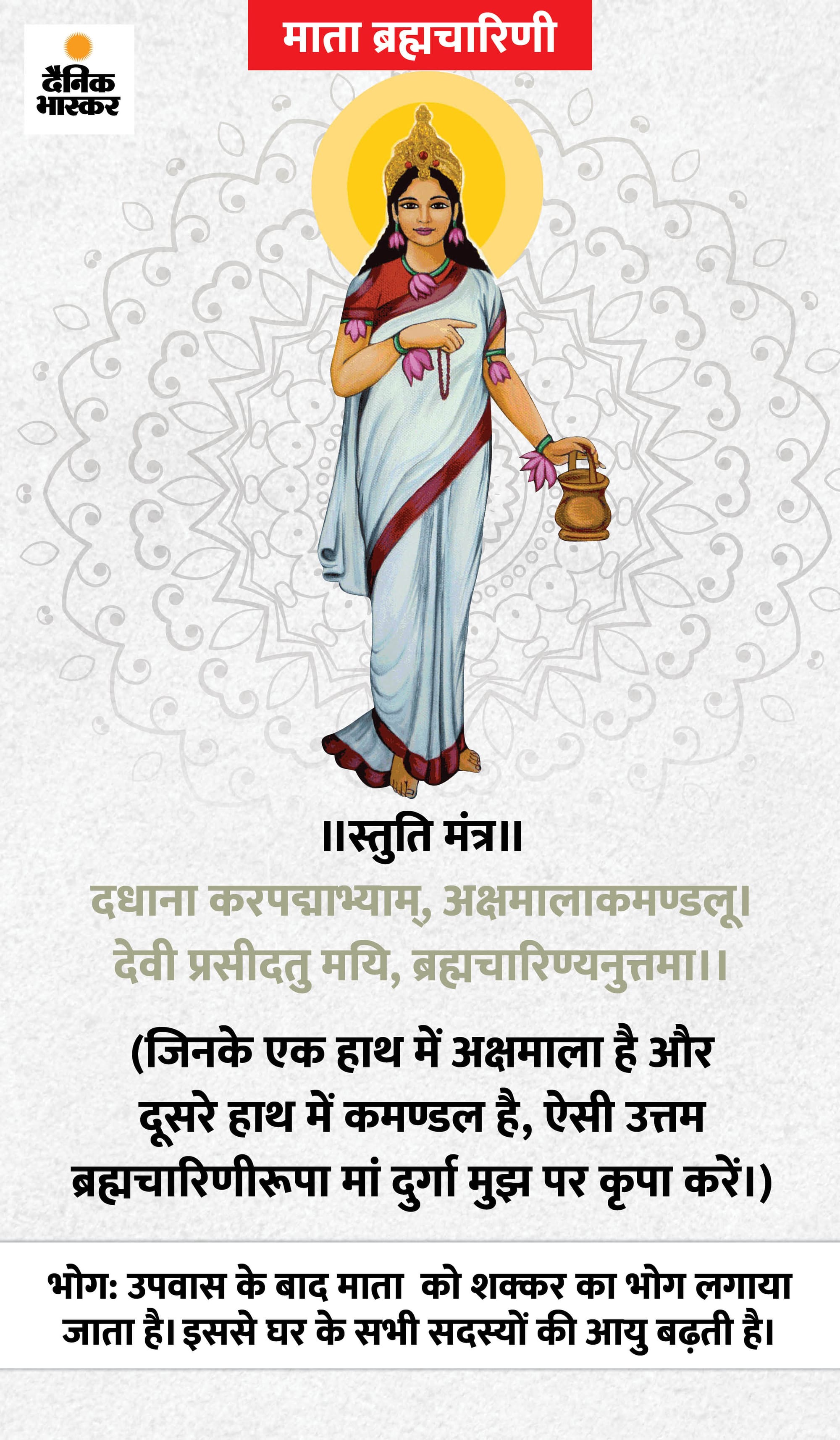Devi Brahmacharini

Devi Brahmacharini - Divine Goddess of penance and renunciation
In the rich culture of Hindu mythology and spirituality, the divine feminine holds a central and revered place. One of the most prominent and worshiped goddesses in Hinduism is Goddess Brahmacharini. She is the embodiment of asceticism, asceticism and spiritual quest, and her worship is deeply rooted in the cultural and religious traditions of India. In this comprehensive exploration with DharmikShree, we will look into the multifaceted aspects of Goddess Brahmacharini, her origins, characteristics, symbolism , will explore the legends and their profound significance in the lives of devotees.
Origin and historical importance:
Goddess Brahmacharini is one of the forms of Goddess Durga, the ultimate feminine cosmic power in Hinduism. Her name, "Brahmacharini", can be divided into two parts: "Brahma", symbolizing the ultimate reality or supreme cosmic power, and "Charini", meaning a female follower or ascetic. Also, her name translates to "one who walks the path of the highest reality."
The first mention of this form of the goddess is found in ancient Hindu scriptures, specifically in the "Durga Saptashati", a sacred text that narrates stories of the goddess's valor and her fight against the demon Mahishasura. Goddess Brahmacharini is glorified as one of the forms of the goddess who was instrumental in the destruction of evil forces.
Attributes and Symbolism:
Appearance:
Goddess Brahmacharini is depicted as a young woman with two hands. She holds a "japamala" (prayer beads) in one hand and a "kamandalu" (a water pot) in the other hand. Her attire is simple, consisting of a white saree and a slight smile on her face.
Penance and renunciation:
She symbolizes the spirit of penance, self-discipline and search for truth. The "Japamala" and "Kamandala" represent his unwavering devotion and commitment towards his spiritual journey.
Determination:
Devi Brahmacharini's unwavering dedication and determination is a source of inspiration for those who want to overcome challenges and obstacles in their lives. His name is often invoked by those practicing rigorous spiritual practices.
Perseverance:
The goddess is known for her perseverance and resilience, which are highly regarded qualities in the pursuit of spiritual enlightenment. His devotees pray for strength and unwavering resolve in their spiritual endeavours.
Legends and mythological stories:
Legend of Sati and Parvati:
In Hindu mythology, Sati, daughter of King Daksha, married Lord Shiva against her father's wishes. Later, due to disrespect towards Shiva, she immolated herself in the fire of her father's yagya.
After her death, Sati is reborn as Parvati, and her journey of penance and penance to win the love of Lord Shiva is a central theme associated with the goddess Brahmacharini.
Battle against Mahishasura:
Goddess Brahmacharini is considered to be one of the forms of Goddess Durga, who was created by the gods to defeat the demon Mahishasura. The fight between the goddess and the demon symbolizes the eternal struggle between good and evil. Goddess Brahmacharini, in this form, symbolizes determination to conquer the forces of darkness.
Parvati's Penance:
Parvati's intense penance and meditation to get Lord Shiva as her husband is an important legend related to Goddess Brahmacharini. He performed rigorous penance, renounced worldly pleasures and lived the life of an ascetic to achieve his divine goal.
Philosophical and Spiritual Importance:
The form and qualities of Goddess Brahmacharini hold deep philosophical and spiritual significance. She represents the constant search for truth, knowledge and liberation from the cycle of birth and death. Her unwavering determination and ascetic practice epitomize the path of renunciation and meditation that leads to spiritual awakening.The association of the goddess with tapasya also highlights the importance of self-discipline and control over desires as a prerequisite for inner transformation. Her simple attire and minimal possessions remind devotees of the transience of material pleasures and the impermanence of the material world.Devotees of Goddess Brahmacharini seek her blessings to overcome obstacles, attain self-realization and develop the qualities of determination, focus and dedication in their spiritual endeavours.
Importance in Hindu worship:
The worship of Goddess Brahmacharini holds a special place in Hindu rituals and festivals, especially during Navratri, the nine-night festival celebrating Goddess Durga. The second day of Navratri is dedicated to Goddess Brahmacharini, and her worship includes the following customs and practices
Fasting: Devotees observe fasts and abstain from food or specific dietary restrictions as a symbol of their commitment to self-discipline and asceticism.
Prasad: Flowers, incense and lamps are offered to the goddess. Her favorite flower, jasmine, is widely used.
Chanting of Mantras: Devotees chant mantras and prayers dedicated to Goddess Brahmacharini to seek her blessings and guidance in their spiritual journeys. for example :
Hreem Shri Ambikaayi Namah.Dadhana Kapabhyamkshamalakamandlu.Devi Prasidatu Mayi Brahmacharinyanuttama.
Ya Devi Sarvabhutesu Ma brahmacharini Rupena Sansthita
Meditation and Yoga:
It is believed that practicing meditation and yoga on this day brings one’s mind and body in line with the principles of penance and austerity.•
Charitable works:
Many people are inspired by the goddess’s penance, emphasizing selflessness and compassion to perform acts of charity and service.



